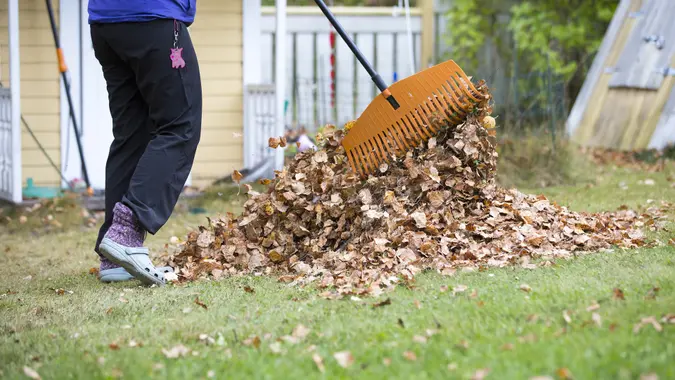I Started a Side Hustle with $36 and Now Make 6 Figures — 7 Things I Did To Get There

Commitment to Our Readers
GOBankingRates' editorial team is committed to bringing you unbiased reviews and information. We use data-driven methodologies to evaluate financial products and services - our reviews and ratings are not influenced by advertisers. You can read more about our editorial guidelines and our products and services review methodology.

20 Years
Helping You Live Richer

Reviewed
by Experts

Trusted by
Millions of Readers
What if you could turn a $36 idea into a six-figure business you can run online in just an hour or two a day? That’s exactly what Dennis Tinerino, a Los Angeles-based entrepreneur, did by launching a flexible, location-independent side hustle: Domain investing.
In an interview with Entrepreneur, Dennis revealed that he buys and sells domain names (what he calls the online equivalent of real estate). Businesses and entrepreneurs looking for memorable or brandable domain names often pay hundreds, thousands or even tens of thousands of dollars to own the right one. Over time, Dennis built a portfolio of thousands of domains, using data and strategy to grow his earnings steadily.
And the best part? He does it all online, on his own schedule, without needing a big team or fancy tech. Here’s how he got started, and the seven key steps he took to build a six-figure online business from a $36 investment.
1. He Treated Domains Like Digital Real Estate
Tinerino’s “aha moment” came in 2014 while launching a website. When he learned that certain web domains could sell for six figures, he realized domain names were like prime real estate — only online. This sparked his interest and led him down the rabbit hole of domain investing.
He started by researching blogs and marketplace FAQs, learning how to buy, price and sell domains. With just $36, he purchased four domain names, one of which, LawyerBoss.com, sold for $700 only two months later. That quick win proved the concept and lit the spark that turned his side project into a business.
If you plan to explore domain investing or any digital side gig, treat it like an investment, not a gamble. In the same way real estate investors study neighborhoods and property values, digital entrepreneurs should study search trends, branding demand and niche markets.
2. He Invested in Self-Education Early
In hindsight, Tinerino said his biggest mistake was not investing in proper training right away. He spent months figuring things out through trial and error — something he could have avoided with structured education.
Today, he recommends courses like Domain Academy and stresses that learning how domains are valued, marketed and traded can save beginners both time and money. According to Tinerino, you can’t just buy cool-sounding names and hope for the best. Like many other types of businesses, education pays for itself.
In nearly every popular side hustle whether freelance work, reselling or online content creation, skills pay off more than software or gadgets.
Before spending money on domains, equipment or marketing, consider:
- Taking a foundational course
- Learning best practices from pros
- Reading expert-backed guides on building profitable side gigs
3. He Learned From Mistakes, Especially Legal Ones
Early on, Tinerino made a common mistake: He tried to sell domain names that were similar to existing trademarks. The result? A stack of cease-and-desist letters.
Fortunately, he resolved each case amicably, but the experience was a wake-up call. He now researches trademarks before buying or pitching any domain. His takeaway: Always check for intellectual property conflicts before investing, because one legal misstep can derail your entire side hustle.
Whether you’re selling products, starting a YouTube channel, freelancing, or investing in digital assets, legal oversights can be costly. A few rules of thumb:
- Avoid trademarked words, brands or phrases
- Check domain availability and trademark databases
- If you start a business, understand basic business structure and tax responsibilities
4. He Focused on Quality Over Quantity
During his first year, Tinerino earned only a few thousand dollars. But by year two, he began refining his portfolio by dropping weak domains and buying better-quality names that had true market value.
As his skills improved, his side hustle quickly ramped up to steady five-figure earnings and eventually into six figures. Today, his portfolio holds 8,000 to 10,000 domains, and he continues to add 500 to 1,000 more each year, mostly focusing on .com extensions since they hold the most resale value.
Many side hustlers overwhelm themselves by trying to do everything instead of doing the right things. The quality-over-quantity mindset is crucial across all money-making routes:
- A few high-paying freelance clients beat dozens of low-paying ones
- A well-optimized blog can outperform 50 mediocre posts
- One high-quality product can outperform 20 rushed ones
5. He Built Systems To Stay Organized
Managing thousands of domains takes serious organization. Tinerino dedicates one to two hours daily, about 60 to 80 hours per month, to portfolio maintenance, searching for new names, marketing and closing deals. He relies on detailed spreadsheets, workflows and management tools to keep renewals, pricing and leads in order.
“Once you get past a few hundred domains, daily portfolio management becomes essential and it’s easy to let small tasks slip through the cracks,” he explained. His systems help keep him from missing opportunities and making costly mistakes.
For anyone building a side hustle, systems are what turn effort into actual income. You don’t need complex software. A simple spreadsheet or project-management tool can be more than enough. Block off a regular “maintenance hour,” keep organized notes and track your progress so you can make decisions based on data rather than guesswork.
6. He Built a Community Around His Expertise
While domain investing can feel solitary, Tinerino found strength in community. He connected with other investors on X (formerly Twitter), exchanging advice and insights.
In 2019, he took it further by launching Domain Smoke, a daily newsletter curating domain auctions, investment opportunities and industry news. What started as a resource for his own notes has become a go-to read for thousands of domain investors around the world.
Community matters because it gives you a place to learn, ask questions and stay motivated whether you’re flipping domains, freelancing or running an e-commerce shop. The more connected you are, the more quickly you discover opportunities and avoid common mistakes.
If you’re just starting a side hustle, consider joining online groups, following industry leaders or engaging in conversations where your future customers or peers hang out.
7. He Never Stopped Learning and Adapting
Even after hitting six figures, Tinerino insists that continuous learning is non-negotiable. Markets shift, trends change and what worked yesterday might not work tomorrow. He stays sharp by following domain blogs, tuning into “Domain Sherpa” shows and analyzing sales data from platforms like NameBio and DNJournal.
“Follow the data,” he said. “It tells you what’s working, what’s trending, and what to avoid.”
This mindset is crucial for anyone hoping to build a long-lasting side hustle. Whether you’re freelancing, building a YouTube channel, or selling digital products, the strategies that work today might not work six months from now. Commit to ongoing learning, watch what leaders in your field are doing, and adjust your approach as trends evolve. Your willingness to adapt and learn is one of the biggest differences between a side hustle that fizzles out and one that keeps growing year after year.
The Takeaway
Dennis Tinerino’s story proves that you don’t need a huge investment to start building wealth. You need curiosity, consistency and the willingness to learn. He turned $36 and a few hours a day into a six-figure business through research, smart systems and constant education. His advice for aspiring side hustlers: “Start small, stay consistent, and give yourself time to learn. Every successful investor was once a beginner.”
 Written by
Written by  Edited by
Edited by 

























